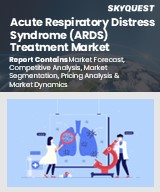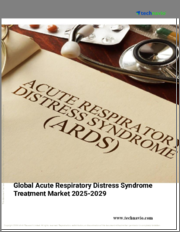
|
시장보고서
상품코드
1764766
급성 호흡 곤란 증후군 치료 시장(2025-2032년) : 약제 유형별, 투여 경로별, 유통 채널별, 지역별 규모, 점유율 및 성장 분석과 산업 예측Acute Respiratory Distress Syndrome Treatment Market Size, Share, and Growth Analysis, By Drug Class, By Route of Administration, By Distribution Channel, By Region - Industry Forecast 2025-2032 |
||||||
급성 호흡 곤란 증후군 치료 세계 시장 규모는 2023년에 39억 달러로 평가되었고, 예측기간(2025-2032년) 동안 CAGR 5.8%로 2024년 41억 3,000만 달러에서 2032년에는 64억 8,000만 달러로 성장할 전망입니다.
급성 호흡 곤란 증후군(ARDS) 치료 시장은 호흡기 질환의 유병률 증가, 노화, 오염 수준 상승, 생활 습관 진화 등의 요인에 의해 크게 성장할 전망입니다 COVID-19 팬데믹 후의 의식의 고조와 정부의 뒷받침이 비침습적 환기법과 체외막 산소 요법(ECMO)의 진보에 박차를 가해 치료 성과를 향상시키고 약제, 인공 호흡기, ICU 자원에 대한 시장 수요를 촉진하고 있습니다. 또한, 노인층은 특히 중증 폐 질환에 걸리기 쉬우므로 환자층이 확대되고 있습니다. 하지만 업계는 비용, 숙련된 전문가 부족, 진단 지연, 혁신적인 치료법의 도입을 방해하는 규제상의 장애물 등의 과제에 직면하고 있으며, 따라서 이해관계자에게는 기회와 과제 모두 존재합니다.
목차
소개
- 조사 목적
- 조사 범위
- 정의
조사 방법
- 정보 수집
- 2차 및 1차 데이터 방법
- 시장 규모 예측
- 시장의 전제조건과 제한
주요 요약
- 세계 시장 전망
- 공급과 수요 동향 분석
- 부문별 기회 분석
시장 역학과 전망
- 시장 개요
- 시장 규모
- 시장 역학
- 성장 촉진요인과 기회
- 억제요인과 과제
- Porter's Five Forces 분석
주요 시장 인사이트
- 주요 성공요인
- 경쟁도
- 주요 투자 기회
- 시장 생태계
- 시장의 매력 지수(2024년)
- PESTEL 분석
- 거시경제지표
- 밸류체인 분석
- 가격 분석
- 기술 분석
- 사례 연구
급성 호흡 곤란 증후군 치료 시장 규모 : 약제 유형별 &CAGR(2025-2032년)
- 시장 개요
- 혈관 수축제
- 기관지 확장제
- 스테로이드와 항생제
- 일산화질소
- 진정제와 마비제
- 계면활성제
- 기타
급성 호흡 곤란 증후군 치료 시장 규모 : 투여 경로별 &CAGR(2025-2032년)
- 시장 개요
- 경구
- 주사
- 흡입
급성 호흡 곤란 증후군 치료 시장 규모 : 유통 채널별 &CAGR(2025-2032년)
- 시장 개요
- 병원 약국
- 소매 약국
- 온라인 약국
- 기타
급성 호흡 곤란 증후군 치료 시장 규모 : 지역별 &CAGR(2025-2032년)
- 북미
- 미국
- 캐나다
- 유럽
- 독일
- 스페인
- 프랑스
- 영국
- 이탈리아
- 기타 유럽
- 아시아태평양
- 중국
- 인도
- 일본
- 한국
- 기타 아시아태평양
- 라틴아메리카
- 브라질
- 기타 라틴아메리카
- 중동 및 아프리카
- GCC 국가
- 남아프리카
- 기타 중동 및 아프리카
경쟁 정보
- 상위 5개사 비교
- 주요 기업의 시장 포지셔닝(2024년)
- 주요 시장 기업이 채용한 전략
- 최근 시장 동향
- 기업의 시장 점유율 분석(2024년)
- 주요 기업의 기업 프로파일
- 기업의 상세
- 제품 포트폴리오 분석
- 기업의 부문별 점유율 분석
- 전년 대비 수익 비교(2022-2024년)
주요 기업 프로파일
- Biomarck Pharmaceuticals
- Athersys
- Healios
- Direct Biologics
- Arch Biopartners
- APEPTICO Forschung und Entwicklung GmbH
- Staidson(Beijing) Bioharmaceuticals
- MediciNova
- Edesa Biotech
- Light Chain Biosciences
- Boehringer Ingelheim
- Genentech
- Windtree Therapeutics
- Veru
- Mesoblast Limited
- Avalo Therapeutics
- Pluristem Therapeutics
- ILTOO Pharma
결론과 권고
CSM 25.07.15Global Acute Respiratory Distress Syndrome Treatment Market size was valued at USD 3.9 billion in 2023 and is poised to grow from USD 4.13 billion in 2024 to USD 6.48 billion by 2032, growing at a CAGR of 5.8% during the forecast period (2025-2032).
The Acute Respiratory Distress Syndrome (ARDS) Treatment Market is poised for significant growth, fueled by factors such as the increasing prevalence of respiratory disorders, an aging population, escalating pollution levels, and evolving lifestyle habits. Heightened awareness and government backing following the COVID-19 pandemic have spurred advancements in non-invasive ventilation methods and extracorporeal membrane oxygenation (ECMO), enhancing treatment outcomes and propelling market demand for drugs, ventilators, and ICU resources. Furthermore, the geriatric demographic is particularly susceptible to severe lung conditions, broadening the patient base. However, the market faces challenges, including high treatment costs, a shortage of skilled professionals, delayed diagnoses, and regulatory hurdles that can impede the introduction of innovative therapies, presenting both opportunities and obstacles for stakeholders.
Top-down and bottom-up approaches were used to estimate and validate the size of the Global Acute Respiratory Distress Syndrome Treatment market and to estimate the size of various other dependent submarkets. The research methodology used to estimate the market size includes the following details: The key players in the market were identified through secondary research, and their market shares in the respective regions were determined through primary and secondary research. This entire procedure includes the study of the annual and financial reports of the top market players and extensive interviews for key insights from industry leaders such as CEOs, VPs, directors, and marketing executives. All percentage shares split, and breakdowns were determined using secondary sources and verified through Primary sources. All possible parameters that affect the markets covered in this research study have been accounted for, viewed in extensive detail, verified through primary research, and analyzed to get the final quantitative and qualitative data.
Global Acute Respiratory Distress Syndrome Treatment Market Segments Analysis
Global Acute Respiratory Distress Syndrome Treatment Market is segmented by Drug Class, Route of Administration, Distribution Channel and region. Based on Drug Class, the market is segmented into Vasoconstrictors, Bronchodilators, Steroids and Antibiotics, Nitric Oxide, Sedatives & Paralytics, Surfactant and Others. Based on Route of Administration, the market is segmented into Oral, Injection and Inhalation. Based on Distribution Channel, the market is segmented into Hospital Pharmacies, Retail Pharmacies, Online Pharmacies and Others. Based on region, the market is segmented into North America, Europe, Asia Pacific, Latin America and Middle East & Africa.
Driver of the Global Acute Respiratory Distress Syndrome Treatment Market
The rising prevalence of respiratory ailments such as pneumonia, chronic obstructive pulmonary disease (COPD), and post-COVID syndrome significantly drives the Global Acute Respiratory Distress Syndrome (ARDS) Treatment market. Contributing factors, including air pollution and smoking, are exacerbating the global patient demographic. This trend highlights an escalating need for expedited diagnostics and enhanced intensive care unit (ICU) capabilities in both developed and developing regions. The increasing burden of these respiratory conditions underscores the urgency for innovative treatment options and improved healthcare infrastructure, ultimately fueling market growth and shaping the future of ARDS management across the globe.
Restraints in the Global Acute Respiratory Distress Syndrome Treatment Market
The lack of FDA-approved medications specifically designed for Acute Respiratory Distress Syndrome (ARDS) limits the available treatment options and stifles pharmaceutical innovation. Current therapies are often adaptations from treatments intended for other inflammatory or respiratory diseases, leading to variable results. This regulatory gap disrupts the establishment of standardized treatment protocols, which in turn hampers investment in the development of targeted therapies. Consequently, the overall growth of the ARDS treatment market, both clinically and commercially, is significantly hindered as stakeholders remain cautious about pursuing advancements in this area due to the associated challenges and uncertainties.
Market Trends of the Global Acute Respiratory Distress Syndrome Treatment Market
The Global Acute Respiratory Distress Syndrome (ARDS) Treatment market is witnessing a transformative trend driven by the integration of AI technologies in personalized medicine. These advanced solutions are enabling healthcare providers to develop tailored treatment plans that leverage patient-specific information, including genetic profiles, biomarkers, and real-time clinical data. This shift towards AI-driven personalized ARDS treatment is anticipated to enhance therapeutic efficacy significantly, resulting in improved patient outcomes and reduced mortality rates. As critical care management evolves with AI optimization, this trend is poised to reshape therapeutic strategies, positioning itself as a pivotal force in the future landscape of ARDS treatment.
Table of Contents
Introduction
- Objectives of the Study
- Scope of the Report
- Definitions
Research Methodology
- Information Procurement
- Secondary & Primary Data Methods
- Market Size Estimation
- Market Assumptions & Limitations
Executive Summary
- Global Market Outlook
- Supply & Demand Trend Analysis
- Segmental Opportunity Analysis
Market Dynamics & Outlook
- Market Overview
- Market Size
- Market Dynamics
- Drivers & Opportunities
- Restraints & Challenges
- Porters Analysis
- Competitive rivalry
- Threat of substitute
- Bargaining power of buyers
- Threat of new entrants
- Bargaining power of suppliers
Key Market Insights
- Key Success Factors
- Degree of Competition
- Top Investment Pockets
- Market Ecosystem
- Market Attractiveness Index, 2024
- PESTEL Analysis
- Macro-Economic Indicators
- Value Chain Analysis
- Pricing Analysis
- Technology Analysis
- Case Studies
Global Acute Respiratory Distress Syndrome Treatment Market Size by Drug Class & CAGR (2025-2032)
- Market Overview
- Vasoconstrictors
- Bronchodilators
- Steroids and Antibiotics
- Nitric Oxide
- Sedatives & Paralytics
- Surfactant
- Others
Global Acute Respiratory Distress Syndrome Treatment Market Size by Route of Administration & CAGR (2025-2032)
- Market Overview
- Oral
- Injection
- Inhalation
Global Acute Respiratory Distress Syndrome Treatment Market Size by Distribution Channel & CAGR (2025-2032)
- Market Overview
- Hospital Pharmacies
- Retail Pharmacies
- Online Pharmacies
- Others
Global Acute Respiratory Distress Syndrome Treatment Market Size & CAGR (2025-2032)
- North America (Drug Class, Route of Administration, Distribution Channel)
- US
- Canada
- Europe (Drug Class, Route of Administration, Distribution Channel)
- Germany
- Spain
- France
- UK
- Italy
- Rest of Europe
- Asia Pacific (Drug Class, Route of Administration, Distribution Channel)
- China
- India
- Japan
- South Korea
- Rest of Asia-Pacific
- Latin America (Drug Class, Route of Administration, Distribution Channel)
- Brazil
- Rest of Latin America
- Middle East & Africa (Drug Class, Route of Administration, Distribution Channel)
- GCC Countries
- South Africa
- Rest of Middle East & Africa
Competitive Intelligence
- Top 5 Player Comparison
- Market Positioning of Key Players, 2024
- Strategies Adopted by Key Market Players
- Recent Developments in the Market
- Company Market Share Analysis, 2024
- Company Profiles of All Key Players
- Company Details
- Product Portfolio Analysis
- Company's Segmental Share Analysis
- Revenue Y-O-Y Comparison (2022-2024)
Key Company Profiles
- Biomarck Pharmaceuticals
- Company Overview
- Business Segment Overview
- Financial Updates
- Key Developments
- Athersys
- Company Overview
- Business Segment Overview
- Financial Updates
- Key Developments
- Healios
- Company Overview
- Business Segment Overview
- Financial Updates
- Key Developments
- Direct Biologics
- Company Overview
- Business Segment Overview
- Financial Updates
- Key Developments
- Arch Biopartners
- Company Overview
- Business Segment Overview
- Financial Updates
- Key Developments
- APEPTICO Forschung und Entwicklung GmbH
- Company Overview
- Business Segment Overview
- Financial Updates
- Key Developments
- Staidson (Beijing) Biopharmaceuticals
- Company Overview
- Business Segment Overview
- Financial Updates
- Key Developments
- MediciNova
- Company Overview
- Business Segment Overview
- Financial Updates
- Key Developments
- Edesa Biotech
- Company Overview
- Business Segment Overview
- Financial Updates
- Key Developments
- Light Chain Biosciences
- Company Overview
- Business Segment Overview
- Financial Updates
- Key Developments
- Boehringer Ingelheim
- Company Overview
- Business Segment Overview
- Financial Updates
- Key Developments
- Genentech
- Company Overview
- Business Segment Overview
- Financial Updates
- Key Developments
- Windtree Therapeutics
- Company Overview
- Business Segment Overview
- Financial Updates
- Key Developments
- Veru
- Company Overview
- Business Segment Overview
- Financial Updates
- Key Developments
- Mesoblast Limited
- Company Overview
- Business Segment Overview
- Financial Updates
- Key Developments
- Avalo Therapeutics
- Company Overview
- Business Segment Overview
- Financial Updates
- Key Developments
- Pluristem Therapeutics
- Company Overview
- Business Segment Overview
- Financial Updates
- Key Developments
- ILTOO Pharma
- Company Overview
- Business Segment Overview
- Financial Updates
- Key Developments
















